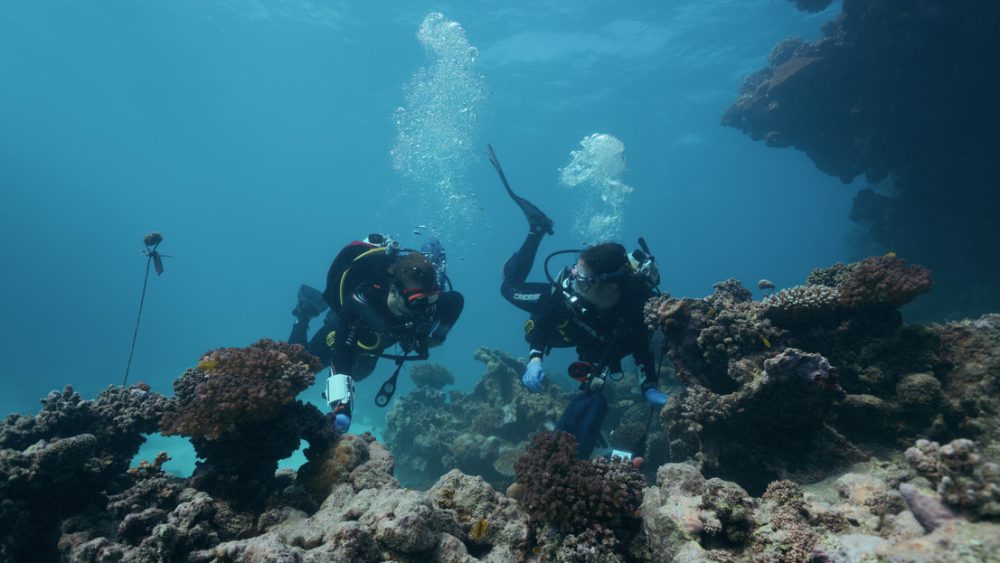A mass bleaching event is hitting coral reefs as rising temperatures warm the world’s oceans. At least 54 countries and territories across the Atlantic, Pacific, and Indian oceans and smaller bodies of water like the Red Sea have experienced bleaching since early 2023. Some experts believe this could become the worst bleaching event on record.
More than half of the world’s reefs have suffered from bleaching-level heat stress in the past year. This stress causes corals to expel the algae living in their tissues, turning them ghostly white. That could spell disaster for the approximately 25% of marine life that depends on healthy coral reefs.
“If you lose reefs, that pushes the entire ocean off-kilter, pushing human society and downstream health off-kilter. So maintaining coral reefs is incredibly important for all dimensions of reducing the human costs of climate change,” said Braden Tierney, a data scientist and research associate in Christopher Mason’s lab at Weill Cornell Medical College.
Tierney is part of an international team of researchers investigating ways to protect coral reefs from bleaching. With the support of a Burroughs Wellcome Fund Human Health and Climate Change seed grant, the team is developing tools that could enable scientists to create probiotics to buffer this fragile ecosystem against the damaging effects of climate change.
Beneficial bugs
People often use specific strains of “good” bacteria or probiotics to maintain their health and well-being, such as to bolster their gut health or strengthen their immunity. The idea of using microbes to boost the health of coral reefs came from Raquel Peixoto, a marine microbiologist at King Abdullah University of Science and Technology (KAUST) in Saudi Arabia. Through a combination of tank-based studies as well as limited field trials, Peixoto has shown that certain probiotics can improve coral resilience to bleaching and coral disease. In a study published in the journal Science Advances, her team showed that dosing coral with a probiotic cocktail helped them survive when water temperatures rose to 30° Celsius (or 86° Fahrenheit).
“Some corals are naturally more resistant to bleaching,” said Erika Santoro, a postdoctoral fellow in Peixoto’s lab and lead author of that seminal study. “We started by selecting the specific bacteria that are beneficial to the corals and then giving those beneficial ones back to protect them.”
However, Santoro and others say the approach is limited by the knowledge of native microbes living in and on reefs. “There are a lot of things that are still unknown,” she said. So far, the search for beneficial microorganisms for corals (BMCs) has relied on older technology that can only give a low-resolution picture of the bacterial communities present. Next-generation sequencing technology could give researchers the high-resolution picture they need to connect specific DNA sequences with characteristics like resilience, but the tools to apply modern sequencing approaches to the complex mixture of organisms and organic material contained within coral do not currently exist.
“Being able to read DNA has accelerated so much of science, but not so for coral reef biology,” said Tierney. “The reason why is delightfully simple. You have this living rock that is a coral reef—most of it is coral DNA, and you need to figure out a set of methods that separate out or deplete the coral, host DNA from the bacterial DNA.”
Up to 90 percent of the DNA in a given reef comes from the corals and the symbiotic algae that give them their color, whereas only 10 percent is derived from bacteria. In contrast, the genetic material of any given person is approximately 50 percent human and 50 percent bacterial. And in the case of stool samples used to study the gut microbiome, “it’s actually flipped—90 percent of the DNA is coming from bacteria,” said Tierney. “So it is much easier to read the bacterial content of the human microbiome than corals.”
Sequencing strategies
Tierney has been using BWF seed funding to test new coral sequencing strategies systematically. He partnered with Peixoto, Santoro, and their team at KAUST, home to the world’s first “Coral Probiotic Village,” a massive natural laboratory in the Red Sea containing a great variety of species of coral. “The Red Sea is a very interesting environment because it’s naturally warmer and has highly fluctuating temperatures,” said Santoro. “It is a great place to study coral resistance to bleaching.”
Diving into their underwater laboratory, Santoro and her colleagues chipped away bits of coral to sample five structurally distinct species. They carefully stored and shipped the samples to Cornell, where the team has been exploring three different tactics to harvest the small fraction of bacterial DNA contained within.
One tactic has been testing different protocols for methodically isolating and purifying DNA. These DNA extraction protocols include a variety of processing steps and chemical solutions, and some combinations might work better than others to break apart coral cells versus bacterial cells, for example. Another tactic involves pre-processing samples with various filters, like straining pasta through a colander. The last tactic employs bioinformatics and data science tools, such as computer algorithms based on reference coral and bacterial genomes, which could further remove contaminating DNA from the final product.
“In essence, what we’ve done over the past year is pilot all these different approaches, and what we are working toward is a big methods paper that is the definitive paper for doing genomics on the coral microbiome,” said Tierney, who also serves as executive director of the Two Frontiers Project. “We expect it to basically set a standard for the field and break open this modern DNA sequencing for corals.”
Tierney notes that researchers still do not know most of the genes or functional pathways contained within coral microbiomes, which was understood for human ecosystems nearly a decade ago. He and his colleagues hope that their techniques can be used to sequence all of the coral and bacterial DNA in a reef and begin to pin down the various factors that make them susceptible or resistant to disease or heat stress. That information is what researchers must have to develop precise, strain-specific probiotics that can protect all coral reefs from climate change.
They hope that carefully selecting the most powerful attributes of probiotics will help to ensure success as they scale up their strategy from laboratory and field experiments into the real world.
“Every experiment that we have done so far has worked well, as we’ve been able to manipulate the microbiome of the coral and protect them from bleaching. So I’m very hopeful,” said Santoro.
However, she also cautioned that governments and other stakeholders must do their part to control climate change because if the oceans warm too much, corals could become so stressed that no amount of probiotics could save them.


Comments are closed.